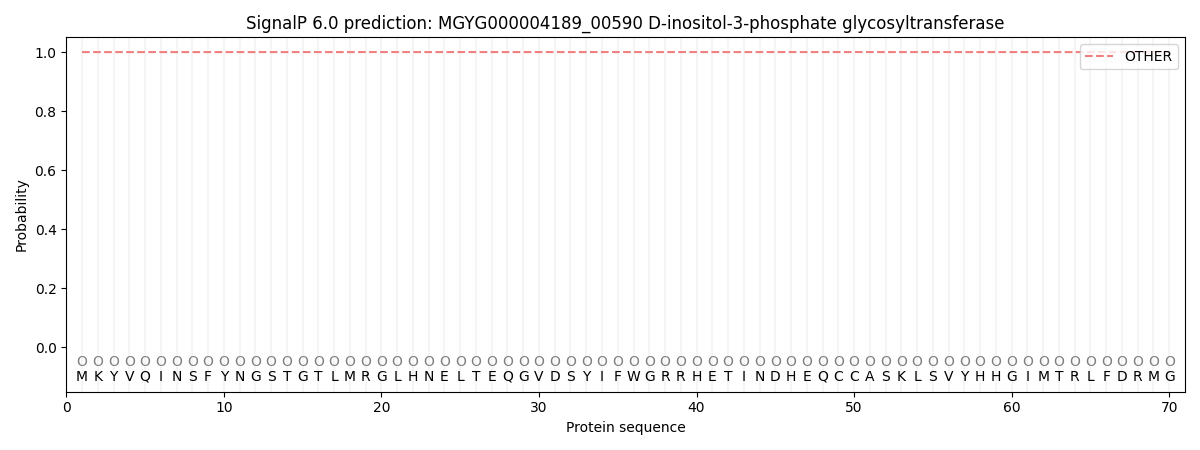You are browsing environment: HUMAN GUT
CAZyme Information: MGYG000004189_00590
You are here: Home > Sequence: MGYG000004189_00590
Basic Information |
Genomic context |
Full Sequence |
Enzyme annotations |
CAZy signature domains |
CDD domains |
CAZyme hits |
PDB hits |
Swiss-Prot hits |
SignalP and Lipop annotations |
TMHMM annotations
Basic Information help
| Species | Slackia_A sp900553655 | |||||||||||
|---|---|---|---|---|---|---|---|---|---|---|---|---|
| Lineage | Bacteria; Actinobacteriota; Coriobacteriia; Coriobacteriales; Eggerthellaceae; Slackia_A; Slackia_A sp900553655 | |||||||||||
| CAZyme ID | MGYG000004189_00590 | |||||||||||
| CAZy Family | GT4 | |||||||||||
| CAZyme Description | D-inositol-3-phosphate glycosyltransferase | |||||||||||
| CAZyme Property |
|
|||||||||||
| Genome Property |
|
|||||||||||
| Gene Location | Start: 26798; End: 27913 Strand: - | |||||||||||
CDD Domains download full data without filtering help
| Cdd ID | Domain | E-Value | qStart | qEnd | sStart | sEnd | Domain Description |
|---|---|---|---|---|---|---|---|
| cd03825 | GT4_WcaC-like | 9.26e-74 | 1 | 346 | 1 | 303 | putative colanic acid biosynthesis glycosyl transferase WcaC and similar proteins. This family is most closely related to the GT4 family of glycosyltransferases. Escherichia coli WcaC has been predicted to function in colanic acid biosynthesis. WcfI in Bacteroides fragilis has been shown to be involved in the capsular polysaccharide biosynthesis. |
| cd03801 | GT4_PimA-like | 7.12e-23 | 8 | 346 | 10 | 307 | phosphatidyl-myo-inositol mannosyltransferase. This family is most closely related to the GT4 family of glycosyltransferases and named after PimA in Propionibacterium freudenreichii, which is involved in the biosynthesis of phosphatidyl-myo-inositol mannosides (PIM) which are early precursors in the biosynthesis of lipomannans (LM) and lipoarabinomannans (LAM), and catalyzes the addition of a mannosyl residue from GDP-D-mannose (GDP-Man) to the position 2 of the carrier lipid phosphatidyl-myo-inositol (PI) to generate a phosphatidyl-myo-inositol bearing an alpha-1,2-linked mannose residue (PIM1). Glycosyltransferases catalyze the transfer of sugar moieties from activated donor molecules to specific acceptor molecules, forming glycosidic bonds. The acceptor molecule can be a lipid, a protein, a heterocyclic compound, or another carbohydrate residue. This group of glycosyltransferases is most closely related to the previously defined glycosyltransferase family 1 (GT1). The members of this family may transfer UDP, ADP, GDP, or CMP linked sugars. The diverse enzymatic activities among members of this family reflect a wide range of biological functions. The protein structure available for this family has the GTB topology, one of the two protein topologies observed for nucleotide-sugar-dependent glycosyltransferases. GTB proteins have distinct N- and C- terminal domains each containing a typical Rossmann fold. The two domains have high structural homology despite minimal sequence homology. The large cleft that separates the two domains includes the catalytic center and permits a high degree of flexibility. The members of this family are found mainly in certain bacteria and archaea. |
| COG0438 | RfaB | 6.27e-20 | 6 | 346 | 9 | 316 | Glycosyltransferase involved in cell wall bisynthesis [Cell wall/membrane/envelope biogenesis]. |
| PRK10125 | PRK10125 | 6.88e-17 | 1 | 357 | 1 | 357 | colanic acid biosynthesis glycosyltransferase WcaC. |
| cd03814 | GT4-like | 2.41e-15 | 188 | 345 | 148 | 306 | glycosyltransferase family 4 proteins. This family is most closely related to the GT4 family of glycosyltransferases and includes a sequence annotated as alpha-D-mannose-alpha(1-6)phosphatidyl myo-inositol monomannoside transferase from Bacillus halodurans. Glycosyltransferases catalyze the transfer of sugar moieties from activated donor molecules to specific acceptor molecules, forming glycosidic bonds. The acceptor molecule can be a lipid, a protein, a heterocyclic compound, or another carbohydrate residue. This group of glycosyltransferases is most closely related to the previously defined glycosyltransferase family 1 (GT1). The members of this family may transfer UDP, ADP, GDP, or CMP linked sugars. The diverse enzymatic activities among members of this family reflect a wide range of biological functions. The protein structure available for this family has the GTB topology, one of the two protein topologies observed for nucleotide-sugar-dependent glycosyltransferases. GTB proteins have distinct N- and C- terminal domains each containing a typical Rossmann fold. The two domains have high structural homology despite minimal sequence homology. The large cleft that separates the two domains includes the catalytic center and permits a high degree of flexibility. The members of this family are found mainly in bacteria and eukaryotes. |
CAZyme Hits help
| Hit ID | E-Value | Query Start | Query End | Hit Start | Hit End |
|---|---|---|---|---|---|
| QOS69951.1 | 2.23e-158 | 18 | 362 | 1 | 340 |
| QUC03714.1 | 3.19e-126 | 1 | 353 | 1 | 444 |
| AMW31976.1 | 2.33e-117 | 1 | 345 | 1 | 340 |
| AFG34269.1 | 1.88e-116 | 1 | 345 | 1 | 340 |
| CEP78286.1 | 3.82e-115 | 1 | 362 | 1 | 357 |
Swiss-Prot Hits download full data without filtering help
| Hit ID | E-Value | Query Start | Query End | Hit Start | Hit End | Description |
|---|---|---|---|---|---|---|
| P71237 | 6.63e-15 | 1 | 357 | 1 | 357 | Putative colanic acid biosynthesis glycosyl transferase WcaC OS=Escherichia coli (strain K12) OX=83333 GN=wcaC PE=4 SV=2 |
| D4GU62 | 3.75e-06 | 212 | 370 | 189 | 354 | Low-salt glycan biosynthesis hexosyltransferase Agl9 OS=Haloferax volcanii (strain ATCC 29605 / DSM 3757 / JCM 8879 / NBRC 14742 / NCIMB 2012 / VKM B-1768 / DS2) OX=309800 GN=agl9 PE=3 SV=1 |
SignalP and Lipop Annotations help
This protein is predicted as OTHER

| Other | SP_Sec_SPI | LIPO_Sec_SPII | TAT_Tat_SPI | TATLIP_Sec_SPII | PILIN_Sec_SPIII |
|---|---|---|---|---|---|
| 1.000058 | 0.000002 | 0.000000 | 0.000000 | 0.000000 | 0.000000 |
